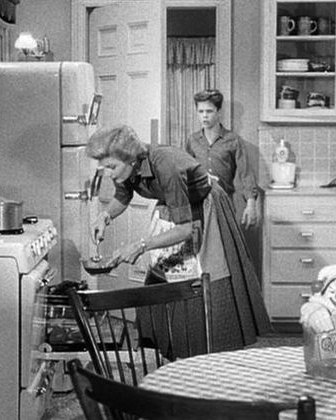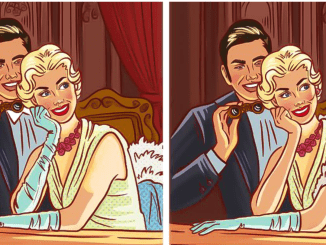The beloved sitcom Leave It to Beaver offered a slice of idealized American family life, capturing the innocence of the 1950s and early 60s. With its lighthearted humor, timeless lessons, and endearing characters, the show has left a lasting impact on generations of viewers. However, even a near-perfect series like Leave It to Beaver had its fair share of goofs and behind-the-scenes quirks that even die-hard fans may have missed. Let’s dive into some of the funniest mistakes and little-known facts from this classic TV show.

Setting a Higher Standard of Wholesome Entertainment
Leave It to Beaver was more than just a family sitcom; it set a standard for wholesome, clean entertainment that resonated with audiences. Unlike many modern shows, which often rely on shock value or complex plots, Leave It to Beaver showcased the simple, everyday challenges of the Cleaver family, with a focus on moral values and good-natured humor. Running from 1957 to 1963, the show portrayed an idealized version of family life, making viewers wish the real world could be a little more like the fictional town of Mayfield.
But even with its reputation for perfection, the show wasn’t immune to occasional slip-ups. Let’s take a look at some of the quirkiest mistakes that found their way onto the screen.
June Cleaver’s Calendar – A Tiny Oversight
June Cleaver, played by Barbara Billingsley, epitomized the perfect mother—graceful, composed, and impeccably organized. Her home was spotless, and her family was well cared for. However, sharp-eyed viewers noticed a minor detail that slipped past the production team: the family calendar hanging on the wall was often out of date! In the 1963 episode “The Poor Loser,” the calendar shows an incorrect year, possibly reusing an old prop from 1961.
For such a meticulous household, this detail is amusingly ironic, reminding us that even the Cleavers weren’t perfect all the time. This little blooper became a fun easter egg for fans who loved spotting the show’s rare imperfections.
The Infamous Misspelling on the Baseball Tickets
In the same episode as the calendar blunder, there’s another easy-to-miss mistake. Ward and Beaver prepare to head out for a baseball game, and a close-up of their tickets reveals a small but noticeable error. The name of their town, “Mayfield,” is misspelled as “Mayfied” in the smaller print. While the larger print gets it right, the goof in the smaller text went unnoticed by most fans, adding a touch of unintentional humor to the episode.
This slip-up might seem small, but it’s one of those quirks that makes fans appreciate the human element behind the show’s production.
The Fake Bee in “The Silent Treatment”
Special effects in the 1950s were nowhere near as sophisticated as they are today, and the Leave It to Beaver team sometimes had to get creative. In the episode “The Silent Treatment,” Beaver has a humorous encounter with a bee while painting a door. Instead of using a real bee, which would have been challenging to control on set, the crew opted for a fake bee suspended on a string.
Look closely, and you can spot the string bouncing around near Beaver’s face! While it might not be realistic by today’s standards, this low-budget special effect added a charming, whimsical touch to the scene and showcased the creativity of the production team.
Jerry Mathers’ Audition: The Cub Scout Who Didn’t Want to Be There
Jerry Mathers, who played the adorable Theodore “Beaver” Cleaver, landed his iconic role in a memorable way. When he auditioned, he showed up in his Cub Scout uniform, as he had a scouting event to attend afterward. Rather than being excited about the audition, young Mathers was more concerned about making it to his Cub Scout meeting on time.

This honesty and unfiltered charm impressed the show’s creators, Joe Connolly and Bob Mosher, who saw in Mathers the perfect blend of innocence and relatability. Ironically, once he got the role, Mathers had little time for scouting due to his rigorous filming schedule, but his audition story has since become legendary.
Tony Dow Wasn’t the Original Wally
Tony Dow will always be remembered as Wally Cleaver, the cool, all-American big brother to Beaver. But here’s a surprise: Dow wasn’t originally cast as Wally. In the pilot episode, the role was played by Paul Sullivan, who was eventually replaced because he experienced a growth spurt that made him look too mature for the part.
Dow stepped into the role and made Wally a relatable, grounded character. His portrayal helped solidify the show’s sibling dynamic, creating an on-screen brotherhood that felt authentic and genuine.
June Cleaver’s Pearls – A Practical Choice with a Hidden Purpose
June Cleaver’s look is iconic, particularly her ever-present pearls and high heels. While these might seem like purely stylistic choices, they served a practical purpose. Barbara Billingsley wore pearls to cover a small surgical scar on her neck, a detail she preferred to keep hidden. The high heels, meanwhile, were a clever solution to ensure she remained visually even in height with her growing “sons.”
These small details not only added to June’s refined look but also helped the actress feel comfortable and confident in her role as the quintessential 1950s mother.
The Real Friendship Between Jerry Mathers and Tony Dow
The chemistry between Jerry Mathers and Tony Dow went beyond their roles as Beaver and Wally—they became true friends off-screen as well. Mathers once remarked that Dow was “the perfect big brother,” and their friendship continued long after the show ended. When Dow passed away in 2022, Mathers expressed his deep sadness, saying that Dow was not just his TV brother but also a lifelong friend.
Their genuine bond added authenticity to their performances, making the Cleaver brothers one of the most memorable sibling pairs in television history.
Television’s First Bathroom Scene
Leave It to Beaver broke ground by featuring the first bathroom scene on television. In the show’s first episode, Beaver and Wally plan to keep a pet alligator in the bathroom, leading to a scene that subtly includes a toilet—a big taboo for TV at the time. Censors initially objected, and the producers had to negotiate just to show the back of the toilet tank.
This small victory paved the way for more realistic depictions of family life on television, making Leave It to Beaver a pioneer in representing everyday details that audiences could relate to.
The “No Laughing” Policy for Subtle Comedy

Unlike other sitcoms, Leave It to Beaver avoided laugh-out-loud moments, opting instead for subtle humor. The show’s creators wanted a gentle, warm tone, preferring chuckles to loud laughter. They believed the comedy should arise naturally from the characters and situations, rather than relying on exaggerated jokes.
This approach gave Leave It to Beaver a unique charm, making it feel more genuine and family-friendly. The understated humor contributed to the show’s lasting appeal, creating a comforting atmosphere for viewers.
Conclusion: The Endearing Imperfections of a Timeless Classic
Leave It to Beaver remains a cherished part of television history, not only for its portrayal of an idealized family but also for the charming mistakes and quirks that made it human. From misspelled tickets and outdated calendars to fake bees and real friendships, these little imperfections added layers to the show, reminding fans that even the Cleavers weren’t flawless.
The next time you watch Leave It to Beaver, keep an eye out for these fun goofs. They’re all part of what makes this classic show so endearing and memorable, proving that even the smallest bloopers can add to the charm of a timeless family favorite.


